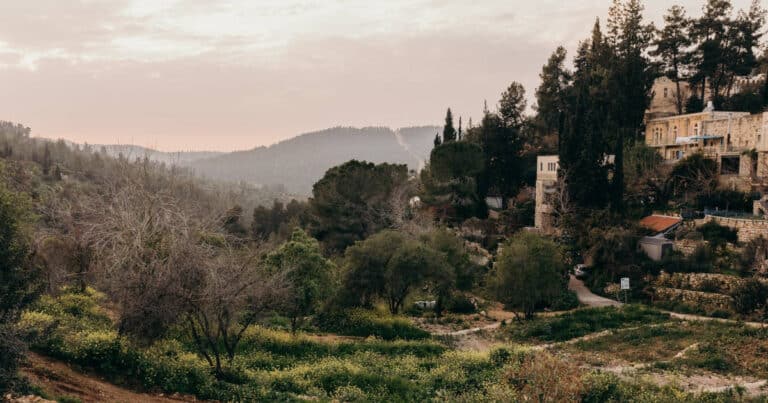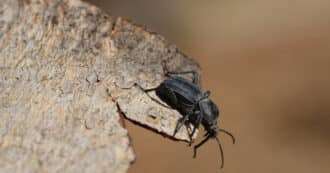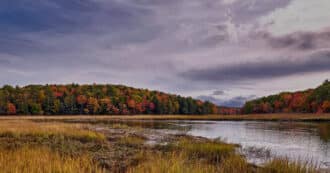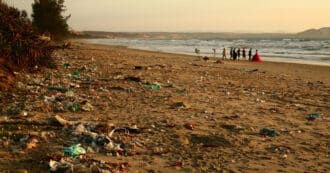By Chelsea Revell and Rabbi Yonatan Neril
Conflict, climate change, consumer society, and quickness of travel. These are the driving forces that put human society at loggerheads with the trees on which it depends. In the past decade, war, arson, climate change, and expansion of roads, cities and industry have reversed some of the gains of the 20th century tree planting in Israel. The human impact on the the trees and forests of the Holy Land is readily apparent to those living on the land. Israel’s trees and forests continue to suffer from human activity, and this should make us think more critically about both connection and commitment to our environment.
19th Century Deforestation and 20th Century Afforestation
In the centuries prior to the early 1900s, several periods of deforestation occurred in Israel. Large-scale destruction of forests unfolded as competing powers sought to advance their hand in the region. The Ottoman Turks harvested vast amounts of timber to fuel their railroad system and armed forces. The Egyptian army performed similarly. Smaller-scale operations added to the crisis: as power shifted in the 1800s, fleeing refugee populations such as the Circassians, displaced by Russian oppression, settled in previously less inhabited areas and naturally put the land’s resources to their own use.
Israel’s landscapes were being profoundly affected by political and militaristic ambitions – yet remarkably, as the 21st century began, Israel was unique in comparison to most countries in that it had more trees than were present a century before. This is largely due to reforestation efforts, which were begun in the early 1900s by the KKL-JNF (Keren Kayemeth LeIsrael-Jewish National Fund) and took hold especially mid-way through the century and forward. Since 1948, around 240 million trees have been planted in Israel (with consideration given to match species and regional ecosystems) under the guidance of the KKL-JNF.
The Fate of Trees in the 21st Century
In 2006, the intense conflict between Israel and Hezbollah of Lebanon, had profound effects on thousands of acreage in northern Israel. That August, rockets launched by Hezbollah ignited hundreds of fires in the Galilee, damaging forests and agricultural plots alike over a six-week course.
Second, Israel experienced its largest fire in modern history when a four-day long blaze in 2010 engulfed around 10,000 acres of land in the Mt. Carmel forest reserve – nearly twice the amount of land affected in the 2006 conflict. Israel had experienced an unusually warm and dry autumn, which followed followed four years of drought. (the same drought in Syria was one of the triggers of the Syrian war.)
The December fire was probably caused when the burning from a nearby garbage dump got out of hand and flames spread. The KKL-JNF estimated that 1.5 million trees were burned. Third, Arson and the tree-cutting by Israelis and Palestinians shows how trees are used as a tool of conflict. During the course of the Carmel fire, waves of arson appeared throughout Israel and West Bank, and investigators concluded that the perpetrators probably took the opportunity to simply “hitch a ride” on the Carmel fire in order to express unrest or perhaps to distract from the Carmel rescue attempts – a tragic testimony to lack of care for the land.
Rabbis for Human Rights, a non-politically-affiliated NGO, frequently engages in olive sapling planting activities to remedy destruction caused by Jewish settlers who attack the olive trees of neighboring Palestinian villages. In October 2013, 400 olive trees were burned in the Palestinian village of Jalud, while more recently in January 2015, 5,000 olive tree saplings were found uprooted or destroyed around the village of Turmus Ayya. Caught between the struggles of human affairs, the land is stripped again and again of its livelihood.
Fourth, in addition to human-caused damage to Israel’s trees in the forest and the agricultural sectors, an increase in the intensity of natural disasters in recent decades may be cause for concern. Even in the last few years it is possible to point out examples: the winter of 2013-2014 brought two powerful storms, one of which – winter storm Alexa – destroyed or damaged tons of thousands of trees. And since an increase of extreme weather events is consistent with the Intergovernmental Panel on Climate Change’s predictions for the present and future, we need to ask ourselves how what kind of effect such a shift might have on the natural world around us – and, to take things a step further, how we as humans might be contributing to that shift.
Fifth, Israel is expanding highway One between Jerusalem and Tel Aviv, and Highway 65 in the Galilee, which has caused the destruction of thousands of trees. With the growth of both population and consumption, the expansion of towns, cities and industrial facilities has had a similar impact.
Deuteronomy 20:19 states ”the human being is a tree of the field.” A Jewish Midrash (commentary– Sifrei) understands this to teach that the fate of the human being is bound up with that of the tree. We depend on trees for so much– food, wood, shade, oxygen, soil retention, and more– and must be wise to protect and care for them. To learn more about trees, Jewish teaching, and caring for the earth, click here.
What Can We Do?
Thus some of the gains the gains made during the 20th century in afforestation efforts in Israel, we are losing as well. What is to be done? Reforesting is an important and admirable activity in many contexts, but it is also worth noting that the natural world has a remarkable ability to rehabilitate itself. Following the Carmel forest fire, many in the public called for plant trees immediately. Yet a consensus among Israeli forest experts agreed to refrain from such plans and rather let nature run its course. Foresters from the University of Haifa Carmel Research Center, the Society for the Protection of Nature in Israel (SPNI), and even the KKL-JNF cautioned against moving too fast, reminding the public that ecologically speaking, natural forest fires function as a mode through which many tree species renew themselves and their populations. Natural seed release from burnt trees yields saplings by the next year, and overplanting can lead to a forest that is too densely planted and even more susceptible to future fires. Alon Rothshild, an expert with the SPNI, stated that “After an event like a fire, there needs to be a natural slow mechanism. The Carmel fire was a tragedy for the environment, but this landscape knows how to rehabilitate itself.” This is not to say that human-caused fires are either permissible or desirable. One lesson to be learned from this is that, as such disasters indeed require a slow mechanism in order for the environment to recover properly, we should be intentionally cautious and thoughtful about the ways in which we interact with our environment. Our environment is not expendable. Our forests are important – they contribute to the removal of carbon dioxide from the atmosphere, enable biodiversity to thrive, offer natural resources, beauty, and community building opportunities. We are bound to the natural world around us. To strip a land of forests is to dislodge an element that is needed for our environment to properly function. And if we threaten it – or stand by as it is threatened – then what, by extension, will become of us?
In Dr. Seuss’s illustrative tale The Lorax, we hear these words: “I am the Lorax. I speak for the trees. I speak for the trees for the trees have no tongues.” All around the globe, the trees have no tongues. In our corner of the world that is the Holy Land, with the recent loss of about two million trees, we need to speak up for them. They were created by God, our existence depends on theirs. For practical actions you can take to protect trees, click here.
***3rd picture from the top: Photo of vine maples against forest by David Patte, USFW, Flickr Creative Commons license; 4th picture from the top: Picture of Common Buckthorn – Image by hspauldi via Flickr used under a Creative Commons Attribution; 5th picture from the top: Photo Credit: Image by 23dingenvoormusea via Flickr Creative Commons;
6th picture from the top: Ruth Henricks Photography – rutheh.com

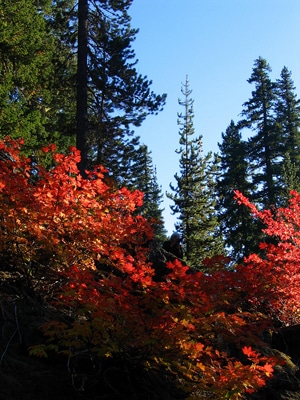
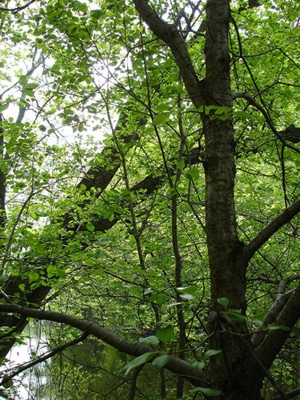
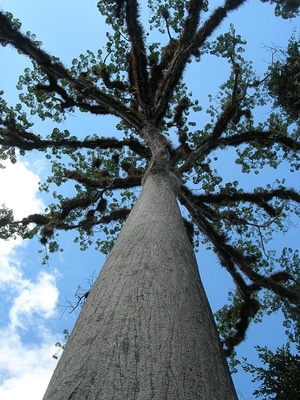
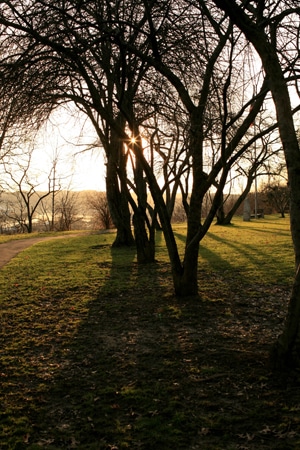
* Featured image source

